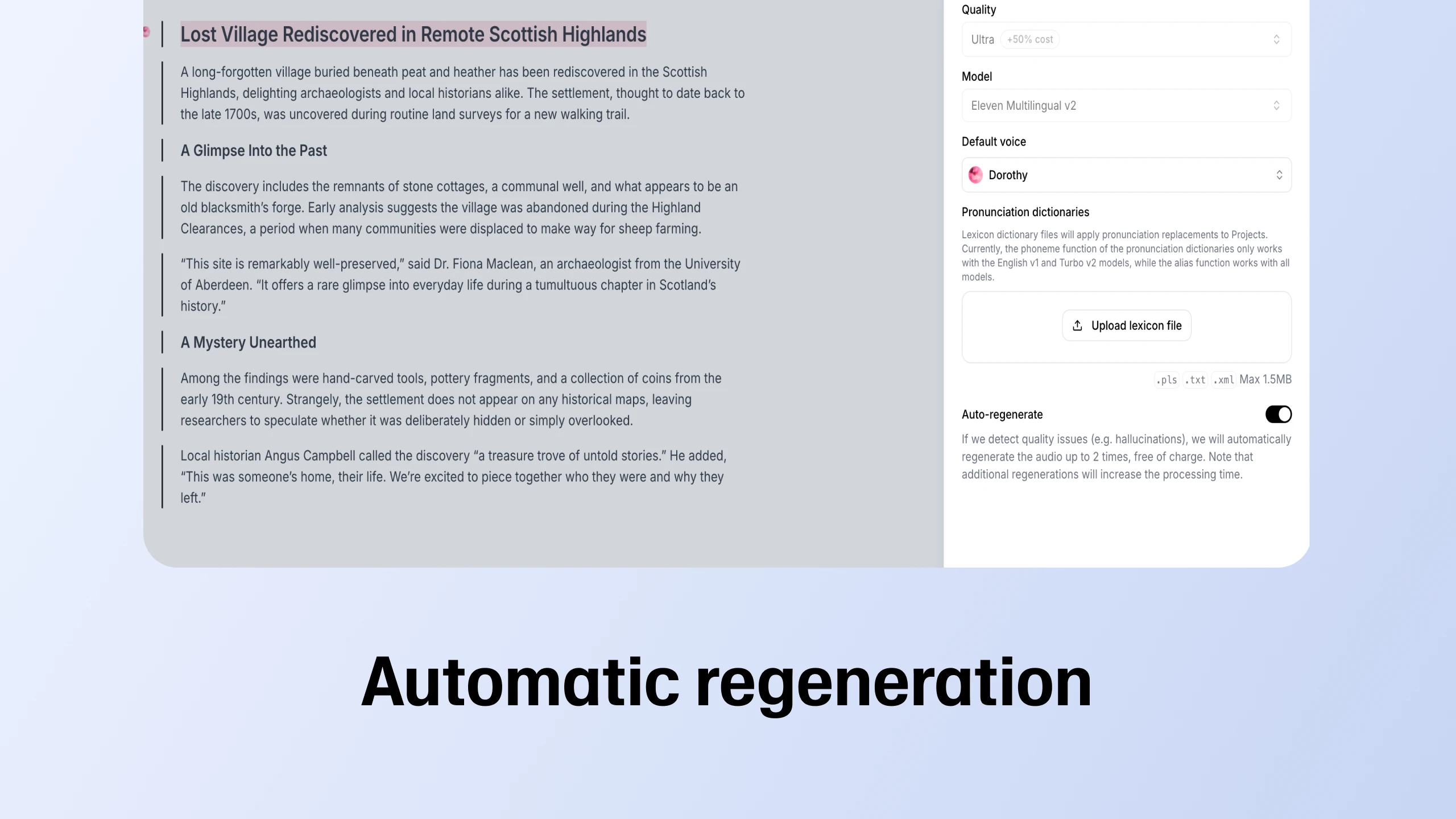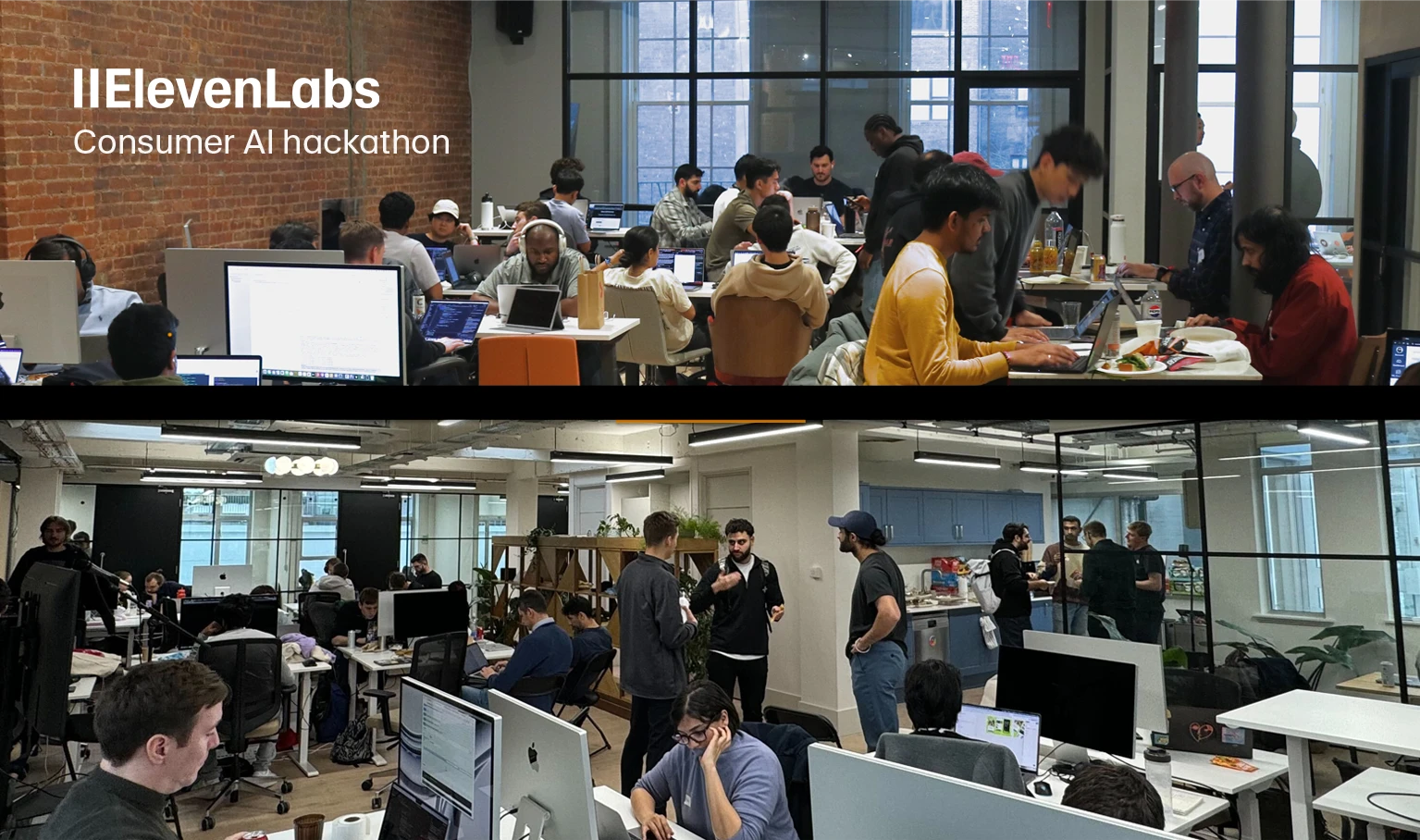
Auto-regenerate is live in Projects
Our long form text editor now lets you regenerate faulty fragments, adjust playback speed, and provide quality feedback
AI allows broadcasters to meet audience demands and drive engagement
With the rise in popularity and accessibility of digital media, traditional broadcasting has been left on the sidelines for far too long. Fortunately, advancements in AI have led to new tools reviving conventional media as we speak, allowing broadcasters to meet audience demands and drive engagement.

Traditional broadcasting was the primary form of media distribution before the digital age. By the term “traditional broadcasting,” we usually refer to traditional media channels like radio and television, which were the dominant mass communication mediums prior to recent years.
Common examples include major television networks like ABC, NBC, CBS, and BBC, AM and FM radio stations, and public broadcasting services like PBS in the States or, once again, BBC in the UK.
However, with the rise of digital media, particularly in the 21st century, traditional broadcasting has had to compete with innovative forms of content distribution, with popular examples including streaming services, podcasts, and social media.
Such examples are also referred to as “new media” since they’ve only been around for a limited period of time and offer more interactive and instant content viewing experiences than traditional media.
Needless to say, the popularity of traditional broadcast media has fallen behind due to the diverse opportunities offered by new media, yet advancements in artificial intelligence can potentially help the once-dominant communication mediums like radio and television get back on their feet.
Prior to exploring the benefits of AI in reinventing traditional media, let’s look at some of the key aspects that differentiate traditional broadcasting from other forms of media and communication:
Rapid advancements in AI have led to many changes in various spheres, including education, entertainment, commerce, accessibility, and broadcasting.
Given that advanced AI tools and software are now accessible to the general public, broadcasters can use them to create and distribute content that aligns with current audience trends. Moreover, creators can rely on AI to improve critical aspects of broadcasting, such as content creation and distribution, productivity, engagement, decision-making, and personalization.
That said, let’s examine some of the most effective ways AI tools are reshaping traditional broadcasting.
Content curation is the essence of all media, including broadcasting. With the rise in popularity of generative AI tools, broadcasters can use various tools to streamline content creation, improve quality, and enhance creativity.
For example, AI algorithms can analyze data and identify trending topics to suggest engaging content ideas. Likewise, advanced video editing tools are now capable of processing raw footage, cutting out unintentional pauses and bloopers, and generating highlight reels.
AI-powered editing tools can also offer automated closed captions, expert dubbing, and subtitles, allowing broadcasters to make their content more accessible. While these accessibility features have been available in the past, they're often expensive, time-consuming, and poor quality as a result. Now, tools like ElevenLabs offer exceptional dubbing voiceovers that are almost indistinguishable from the real thing.
But before we explore the opportunities that artificial intelligence presents to all this, let’s review some key benefits of interactive storytelling.
Interactive storytelling is used across many industries and entertainment genres, and for good reason. This narrative genre provides participants with a more engaging and immersive experience and breaks the fourth wall between creators and audiences.
Likewise, interactive stories can also be used for educational purposes and to link specific actions with potential consequences.
Interactive storytelling can significantly benefit children and young adults, from general knowledge to morality. Common ways interactive stories are incorporated into education include interactive quizzes and infographics, educational games, eBooks, digital video storytelling, and classroom scenario activities.
In addition to being entertaining and engaging, interactive storytelling also facilitates improved information retention. Children (and learners in general) are more likely to remember what they’ve learned when they’re focused, interested, and emotionally invested. Plus, interactive storytelling techniques can make use of tools such as AI narration to tap into additional learning experiences, and improve retention.
But before we explore the opportunities that artificial intelligence presents to all this, let’s review some key benefits of interactive storytelling.
Interactive storytelling is used across many industries and entertainment genres, and for good reason. This narrative genre provides participants with a more engaging and immersive experience and breaks the fourth wall between creators and audiences.
Likewise, interactive stories can also be used for educational purposes and to link specific actions with potential consequences.
Interactive storytelling can significantly benefit children and young adults, from general knowledge to morality. Common ways interactive stories are incorporated into education include interactive quizzes and infographics, educational games, eBooks, digital video storytelling, and classroom scenario activities.
In addition to being entertaining and engaging, interactive storytelling also facilitates improved information retention. Children (and learners in general) are more likely to remember what they’ve learned when they’re focused, interested, and emotionally invested. Plus, interactive storytelling techniques can make use of tools such as AI narration to tap into additional learning experiences, and improve retention.
Additionally, text-to-speech and voice generation tools such as ElevenLabs enhance accessibility while allowing broadcasters to use natural-sounding AI voices for narration purposes. Such tools are especially useful when covering for broadcasters taking time off or temporarily filling presenter vacancies.
Check out the short clip below to see how authentic and human-like TTS tools like ElevenLabs have become:
Lastly, AI technology can also generate virtual sets and various visual effects, opening up a world of creative possibilities for television broadcasters while helping save time and money.
In addition to enhanced content creation, current AI tools can optimize content distribution through metadata optimization, predictive analytics, and network optimization, making it easier and cost-effective to distribute content.
AI tools can generate metadata for various content, allowing users to locate programs and shows more efficiently. Likewise, predictive analytics tools can offer valuable insights into viewing times and audience behavior patterns, allowing broadcasters to tailor their schedules.
Regarding network optimization, AI-powered programs can monitor network performance in real time, identifying and resolving issues and errors before they interfere with the broadcast.
When it comes to productivity and efficiency, AI technology is significantly assisting broadcasters in automating routine tasks that used to require human interference. Broadcasters can boost productivity, save time, and reduce costs by using tools like AI voice recognition, which can convert audio recordings to text for further analysis.
Additionally, facial recognition technology can automatically identify presenters or guests on camera, leaving less room for errors and switch-ups.
Although traditional broadcasting engagement was on the decline, advancements in AI tools are effectively eliminating this challenge. Broadcasters can now use virtual assistants and AI-powered chatbots to interact with viewers, providing them with answers to questions and essential updates regarding programs in real-time.
Likewise, broadcasting companies can integrate AI-based tracking tools and monitor discussions on social media, allowing their SMM managers to respond and engage with audience members on the spot.
In addition to social media monitoring, broadcasters can use AI-driven analytics to gain valuable insights by gathering data from various sources. From understanding viewer engagement levels to tracking audience feedback, advanced analytics tools allow broadcasters to make informed decisions about the type of content to air and at what times.
As a result, broadcasting companies are more likely to witness higher ratings, increased engagement, and more revenue.
While traditional broadcasting is often a prestigious career, it can be difficult to enter, with significant barriers to marginalized communities and low pay. AI is changing this, offering skilled creators the chance to participate in a whole host of new broadcasting and entertainment job options.
Take voice acting, for example. Once the preserve of the well-educated, now, many different types of voices are in demand. Yet a voice actor is naturally limited in the work they can produce, simply because they can only say so many words in one day. This means that those successful actors with distinct, in-demand voices are capped at the output they can generate, even though they have built successful careers.
Enter AI voice cloning: a unique way a voice actor can "clone" their own voice using AI tools to generate unlimited output in a click of a button.
This is restoring opportunities to actors who have suffered from voice damage, or who are struggling to keep up with their heavy workload. Now, through voice cloning, they can still keep up with their workload and even take on more work if they see fit.
The best thing? ElevenLabs also allows voice actors to earn revenue from its platform when they upload their voice to the Voice Library. This opens up a completely new revenue stream for voice actors that was previously inaccessible: passive income.
Voice cloning isn't just a way for voice actors to make money by streamlining the production process. It's also beneficial to all kinds of modern broadcasters, including YouTubers, audiobook authors, social media content creators, and many more.
AI is transforming content personalization, and traditional broadcasting is no exception. As touched upon above, AI analytics tools can analyze demographics and individual viewer preferences and recommend content to suit their tastes.
Such tools can also enable tailored ad placements based on viewer data, enabling dynamic ad insertion that’s relevant for the viewer and profitable for advertisers.
Lastly, AI-powered translation and dubbing tools can provide real-time subtitles and dubs, making content more accessible to a global audience in their own native language – check it out below:
Based on what we know about AI technology and its capabilities, the decrease in popularity of traditional broadcasting may soon be a thing of the past.
AI technology can assist broadcasters, presenters, editors, and scriptwriters in various ways, from content creation and distribution to higher engagement to personalized experiences for viewers. Similarly, AI tools can assist in daily task automation, helping creators focus on what matters - creating engaging content that attracts more viewers.
That said, it looks like traditional broadcasting is on its way to making a massive comeback, and artificial intelligence has assisted significantly in the revival of traditional media.
Ready to harness the power of text-to-speech for broadcasting? Sign up for ElevenLabs today.

Our long form text editor now lets you regenerate faulty fragments, adjust playback speed, and provide quality feedback

Developers brought ideas to life using AI, from real time voice commands to custom storytelling